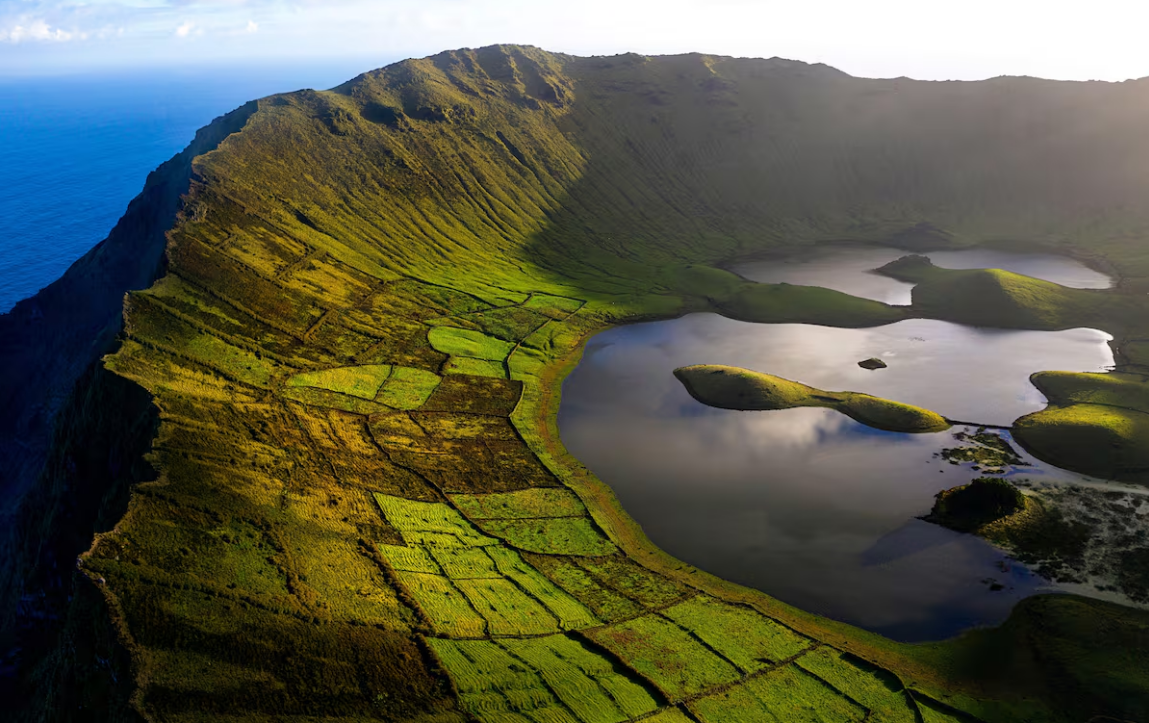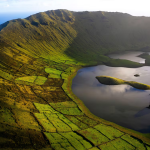At the Edge of Europe: A Journey Through Flores and Corvo in the Azores
Here, Europe seems to fade away. In the middle of the North Atlantic, nearly 2,000 kilometers from any mainland, Flores Island feels like the edge of the world—or its beginning, depending on your perspective. When the sun is out, Flores is a vision of paradise, a lush green jewel rising from the ocean. But when hurricanes sweep through this ocean corridor, as Hurricane Lorenzo did in 2019, destroying the commercial port of Lajes das Flores, the island shows its wild, intimidating face. On a calm April afternoon, standing by the Albernaz Lighthouse—the westernmost beacon of Europe—the Atlantic feels peaceful, its fury momentarily at rest. Yet without storms, there is no true paradise here.
From the lighthouse, two small islets come into view: Maria Vaz, a favorite among divers, and Monchique, a lonely outpost marking Europe’s last tip where you could still, in theory, pay with euros. Geographically, the Azores could have been American territory; history, however, charted its own course. Portuguese sailors claimed Flores and Corvo in the 15th century, and their legacy has been shaped by shipwrecks, piracy, miracles, emigration, and, above all, resilience.
Flores and Corvo, designated UNESCO Biosphere Reserves, are the westernmost islands of the Azores, closer to the U.S. than mainland Europe. For decades, waves of migration carried Azoreans to North America, seeking better opportunities. That “New World” dream dimmed over time, replaced by European Union investment that transformed these remote islands. Today, EU funding supports infrastructure like Corvo’s tiny airport, reminding residents that they are undeniably European.
In late April, Flores lives up to its name only in spirit: the famous blue and purple hydrangeas have yet to bloom, but the island is no less breathtaking. Covering just 143 square kilometers, it feels like a living postcard, with winding roads leading to dramatic viewpoints, volcanic cliffs, and basalt churches. Rocha dos Bordões, a striking columnar rock formation over half a million years old, resembles the spines of a massive stone library. But on Flores, beauty is fleeting. Sunshine can give way to fog and rain in minutes, a reminder that these islands live under the rule of weather.
The island’s volcanic heart holds seven crater lakes, each distinct in color and character. Near two of them, Lagoa Negra and Lagoa Comprida, lies Poço da Ribeira do Ferreiro, perhaps Flores’ most photographed wonder: a series of cascading waterfalls plunging down a 200-meter cliff into a shimmering lagoon. This slice of paradise, now privately owned, has been carefully reshaped with terraced gardens, raising questions about conservation and stewardship.
Close by, Aldeia da Cuada showcases another kind of preservation. Once abandoned by emigrants, the stone village has been reborn as a rural tourism project. Each house bears a plaque with the name of its former owner, paying homage to a history of hardship and resilience.
Dining on Flores reflects the island’s character: simple, rugged, and deeply tied to the land. At Maresía, a restaurant overlooking natural volcanic pools in Fajã Grande, meals are crafted daily from what’s available—an authentic, no-menu experience framed by sunset views. Locals’ preference for beef over fish may surprise visitors, but it reflects the island’s strong cattle industry, a vital resource in such remote terrain.
Hiking trails crisscross the island, with the longest stretching 47 kilometers from Santa Cruz to Lajedo. The southernmost trail leads to Fajã de Lopo Vaz, a secluded volcanic beach accessible only by a steep, narrow path. The descent reveals a pocket of tropical microclimate and an improvised altar with broken statues and offerings left by unknown hands. It’s a world without cell signal, where waves and birdsong dominate.
Corvo, Flores’ sister island, is even more isolated—a mere 17 square kilometers of volcanic rock, home to just over 400 residents. Here, life is simple and communal; emergencies require airlifts, and supplies often come from Flores. Yet Corvo offers its own riches: a harmonious village of stone houses, narrow streets designed to thwart pirates, and an atmosphere Raul Brandão once described as “monastic.” Mayor José Manuel Silva praises its tranquility: “If you visit for only a few hours, you haven’t truly been here. You’ve only passed through.”
At Corvo’s heart lies Caldeirão, a massive volcanic crater with a deep lake surrounded by mossy slopes and tiny islets said to represent the nine islands of the Azores. When the mist lifts—a rare and magical occurrence—the view is breathtaking, as if the world begins here rather than ends.
Both islands embody resilience shaped by centuries of hardship. Once reliant on whaling, Flores and Corvo now thrive on eco-tourism, cultural preservation, and a slower pace of life. Locals have learned to coexist with unpredictable weather, adjusting plans as flights and ferries shift with the winds. Anxiety has no place here; nature dictates the rhythm.
In Flores and Corvo, Europe whispers its final notes, and the Atlantic roars in reply. The journey to these islands is not just a trip to the edge of a map but a step back into a way of life defined by patience, solidarity, and awe for the untamed sea. Here, at the farthest reaches of the continent, it’s easy to believe that paradise is not a postcard image but a balance between beauty and storms—a lesson only islands like these can teach.








